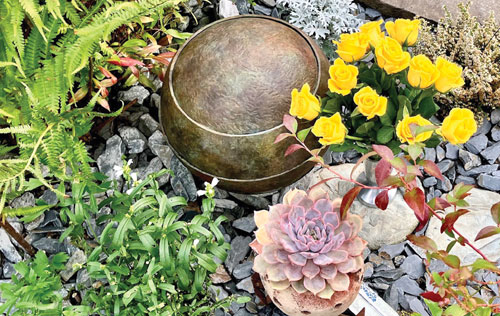Five years ago, I published a column in these pages about a
spectacular private garden I had visited in Birmingham, England. On one occasion, the owners were celebrating their marriage, and there were guests from several countries representing a variety of relationships with the hosts. I had heard talk about the garden before, its breadth of color and species of flower, its benches, statues, and other objects hidden in various corners. But the actual first experience, the encounter with reality, left me tongue-tied. For the wedding celebration, there was also a mime clad in a gray and white toga, amusing guests with her ability to pose perfectly still. The garden was indescribably beautiful.
I returned on several occasions after that initial visit, taking note each time of the changes my brother and brother-in-law had made: the sculptures acquired on trips to old or new places, a rearrangement of flowers or greenery, a repair to the masonry. I got caught up in making sense of this unusual place. It certainly was not an ordinary garden. Even to me, a rare dabbler in horticultural activity, I could recognize the energy, effort, and planning necessary to maintain such a striking plot of land. I began to see it as a means of archiving ideas and objects that represented an organic history of the relationship between my older brother and his musician husband. The garden attracted outsiders while representing those who built it.
They called their residence Vinwood, to signal their partnership with a certain flair. I have always imagined the garden area as the primary structure and the house as a secondary necessity mandated by inclement weather. Sometimes, one needs walls and a roof to assure protection against the rain and cold. Vinwood House (I call it that to distinguish it from the gardens) has steadily matured into a family home, having been tastefully refurbished on several occasions. However, the development of its personality has been subjugated to the thoughtful redefining of Vinwood Garden. On my visits, I was usually entertained outside, in the front or back of the house. If rain was expected, a tent was set up on the back lawn; space heaters were always available for warmth.
The garden became an outdoor concert hall on occasion, to accommodate presentations of music written for clarinet or saxophone choirs. My brother-in-law writes music specifically for those instruments. The proprietors were accustomed to hosting all sorts of discussion groups, small parties, informal and formal receptions, and musical soirées on their lawns. And whatever was needed for comfort’s sake was readily at hand. When the temperature dropped, it was a pleasure to enter the tent and be welcomed by couches, chairs, and a collection of colored blankets. Flickering candles beckoned, obligating me to make a choice about where I would settle. Each little area seemed to promise a unique experience.
This brother and I grew up together in Barbados, shared the same schools, and migrated to the United States with the rest of the family. Once we graduated from high school, our paths diverged. He took up banking, and over the years became known for his distinctive bowties and conservative European suits. In our youth, both of us enjoyed meeting up at events that featured concerts and shows of ethnic Caribbean music. I played with a group of conga drummers, and he was interested in Afro-Cuban dance. We talked excitedly about Pearl Primus (1919-1994), Geoffrey Holder (1930-2014), Jean-Léon Destiné (1918-2013), and other leading choreographers of Afro-Cuban dance.
Eventually, we both retired and settled into routines that made it easier for us to reconnect. We found it convenient to meet in different parts of the world and to spend holidays in places both of our families enjoyed. Christmas seasons in Seville and Paris and a birthday celebrated in Lyon were a pleasure to organize. Zoom meetings also became frequent and brought us back together to catch up on the whereabouts of relatives and friends. As we grew older, we would regale each other with tales of old-time Barbados. As brothers often do, we found time to debate, especially notions of human rights violations and incidents of discrimination. We were both sensitive when it came to having indignities forced on us.
The time came, too, when the pathologies of aging started to bother him, forcing consideration of how these changes would affect the task of maintaining the garden. Before that problem ever met a solution, he died following a short illness. As fortune would have it, his death came after a wonderful vacation in Curaçao. It turns out that Sri Lanka was his favorite island, although he never told me why.
During the last years, he often expressed his wishes for cremation. His ashes now reside in a designated section of the garden. The photo here shows how his resting place has been designed to memorialize the couple’s relationship, experiences, and ultimate separation. My brother ended up finding rest in a home space he had cultivated and worked on for decades. He redefined the meaning of lingering in a garden and prolonged the attachment to those he loved. ■


